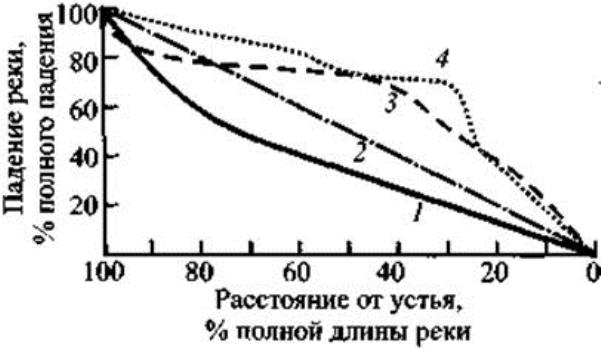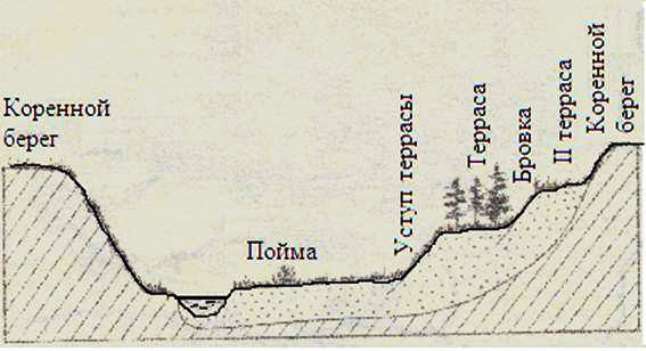River valleys as one of the land surface relief forms are the subject of study of geomorphology. The range of issues of interest to this geological and geographical discipline includes the study of the origin, evolution and structure of river valleys, their dynamics and characteristic features.
What is a river valley?
River valleys are among the negative forms of relief. So called surface areas characterized by a relative decrease in level. The valleys are characterized by a linear elongated shape, more or less complicated by tortuosity. Throughout its length, the valleys have a generally uniform slope.
The structure of the river valley depends on a combination of physical and geographical conditions and geological features inherent in the terrain along which the river flows. The combined effect of these factors can change over time, and such changes also cannot but affect the morphology of the valley.
Genesis and Valley Development
The origin of river valleys may be due to the presence of tectonic conditions conducive to the formation of a river (folds and faults of various types) or the movement of glaciers. However, the main and necessary factor in the emergence of the valley is the work of flowing waters, their erosion activity.
There are such types of water erosion that determine the structure of the river valley, such as:
- Bottom floor, as a result of which the stream cuts into the surface and builds up a recess. Prevails in the early stages of the development of the valley, when the river is just being laid.
- Lateral, expressed in the washout of the coastal stream, which leads to the expansion of the valley. This type of erosion is more pronounced when the river enters the maturity stage. At this time, the river slope decreases significantly as it approaches the equilibrium profile relative to the level of the basin into which it flows (the so-called erosion basis). Under the influence of lateral erosion, the water flow forms meanders - meandering currents.
When the river begins to silt, overgrow, form a large number of swampy old women, this means that it has reached old age. The river valley becomes extremely wide, and the flow slows down. The profile of such an old river is already as close as possible to the erosion basis.
Valley morphology elements
In the process of river evolution, the basic structural elements of the river valley are formed. Briefly describe each of them.
- Channel - a section of the valley along which the main water flow is carried out. It is occupied by the river during inter-flood seasons. The stable elements of the channel are the bottom and coast.
- Floodplain - a more elevated section of the valley, flooded during the flood. Sometimes the floodplain is called the meadow terrace of the river. Within it lies a riverbed, or alluvial shaft formed by sandy and silty sediments.
- Terraces are stepped former floodplains, flooded with water at the previous stages of the development of the valley, when the river crashed even less to the surface. Terraces can be open or buried with subsequent sedimentation.
- Root shores are the boundary edges of the valley. Their level exceeds the upper, earliest river terrace.
The riverbed and floodplain are attributed to the bed, or the bottom of the valley, and the terraces, along with the root banks, to its slopes.
River Valley Profiles
Depending on the slice under which this form of the earth's relief is considered, structural features of the longitudinal and transverse profiles of river valleys are distinguished.
A longitudinal profile is a section of a valley drawn along its length along a line called the thalweg, connecting the lowest points of the bed, that is, along the greatest depth. The longitudinal profile reflects such parameters of the river valley as a fall - a difference in elevations in a particular section and along the entire length - and a slope, understood as the ratio of the fall to the length of the section under consideration.
A transverse profile is a section of a valley in a plane perpendicular to its direction. This is an important indicator of the morphological type of a river valley.
Types of valley profiles along the longitudinal section
In the structure of the longitudinal profiles of river valleys, several types are distinguished depending on how the slopes are distributed along the length of the valley:
- A straight profile is formed when the river along the entire length has a slope close to uniform. Such a valley structure can be found mainly in small rivers.
- The stepped profile is characterized by the difference in slopes in individual sections of the valley. It is inherent in rapids, streams that form waterfalls, reaches or flowing through flowing lakes.
- A smooth concave profile has a general view of an unevenly concave curve. Near the source, this line is steeper, with approaching the mouth it becomes more and more gentle. Such a bottom profile develops in mature rivers, the course of which is confined for the most part to lowland, tectonically calm areas.
- The outburst or convex profile, observed quite rarely, has a slight slope in the upper reaches of the river and significant in the lower reaches of the valley.

The greatest degree of approximation to the ideal equilibrium profile is characteristic of the smoothly concave form of the valley bed, however, in reality, due to the combined action of many factors, the profile always has stepped structure elements.
An example of a complex profile is demonstrated by the structural features of the Mississippi River Valley, one of the greatest waterways in the world. The river valley is morphologically divided into Upper and Lower Mississippi, differing in structure. The first one has a stepped profile with many rapids and rifts; the second is a pronounced plain valley, wide and gentle. Due to the intense siltation, the river has repeatedly changed its channel and the place where it flows into the Gulf of Mexico - this phenomenon is known as the “delta wandering”.
Complex valleys, as if composed of sections with different structures and origins, are inherent in almost all of the largest rivers: the Amazon, the Nile, the Danube, the Volga, the Yenisei and many others.
Classification of valleys by transverse profiles
According to various characteristics such as the width of the bottom of the valley, the steepness of the slopes and the nature of their conjugation with the bed, usually distinguish the following structural types of transverse profiles of river valleys:
- The V-shaped sectional valley has a triangular shape. Such a profile is also called undeveloped. The valleys of this type, as a rule, are young, in them there is an intensive deepening of the bottom and destruction of the slopes due to the processes of collapse, scree, etc. These valleys do not have terraces and pronounced floodplains.
- Valley with a parabolic profile. Its bottom is quite rounded, the slopes are long, but they do not show a step-terrace structure. Their formation is associated with the work of powerful water streams that create a large number of various loose deposits.
- The trapezoidal valley has well-developed terraces and powerful sediments. The presence of a stepped terrace structure indicates a complex and long history, during which the era with the predominance of erosion, expanding and deepening the bed of the valley, alternated with sedimentation eras. The width of the valley can exceed the width of the river bed by an order of magnitude.
- The valley in the form of a gutter differs from the previous type in an even greater width and gentle slopes. In the history of such valleys, sedimentary accumulation epochs prevailed.
- The planimorphic type of the valley with fuzzy boundaries, a large number of channels and branches is characteristic of large, very old rivers.

Geology and structure of river valleys
The tectonics of the area plays a very significant role in shaping the characteristics of the river valley. The presence of structures such as faults or faults contribute to its formation, and crushing zones encountered by the water flow in its path accelerate the erosion process. The nature of the tectonic folds and their orientation relative to the axis of the valley affect the symmetry of its transverse profile. Thus, valleys formed along faults are often asymmetric, while those passing along an anticlinal or synclinal fold, on the contrary, have symmetry.
The structure of the valley also depends on the composition of the rocks composing it, since rocks of various types are susceptible to erosion to varying degrees. Malleable clay rocks facilitate erosion, deepening of the bottom and leaching of the coast. If the stream encounters rocky outcrops of stable rocks, rapids form in the longitudinal profile of the valley.
The practical significance of the issue
Knowledge of the structure of the valley is necessary when designing hydraulic structures, for example, when calculating the strength characteristics of dams and the power of hydroelectric power plants. It is no less important in the construction of bridges, roads, and in the development of territories adjacent to rivers.
The study of the morphology of valleys is also important for the correct assessment of resistance to water erosion of land within river valleys. Ancient, buried river valleys are examined for structure in the exploration of groundwater and placer mineral deposits.
Establishing the stratigraphy of the Quaternary sediments, carrying out paleogeographic reconstructions, and many other scientific questions, in turn, cannot do without taking into account the structure of river valleys. It is easy to see that it is required when solving a wide range of academic and applied problems.